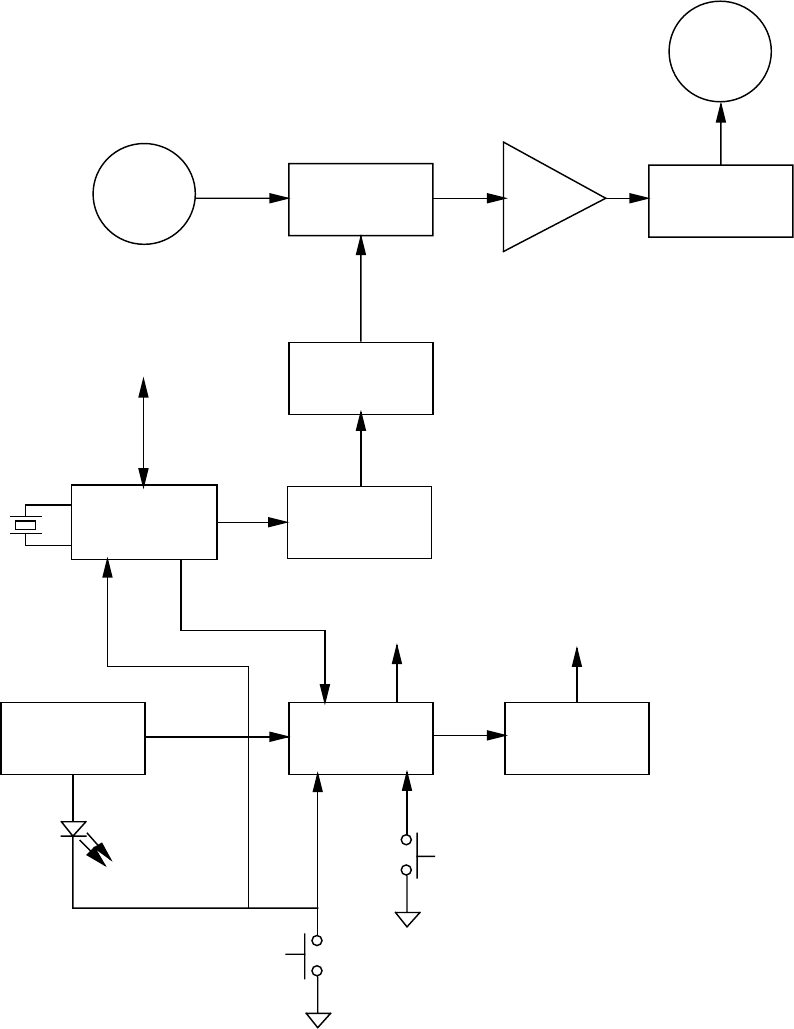Meteorcomm 54530001 REMOTE EMERGENCY DEVICE User Manual MANUAL
Meteorcomm LLC REMOTE EMERGENCY DEVICE MANUAL
MANUAL
FCC TYPE ACCEPTANCE DOCUMENTATION
FOR THE
MCC-54530001 REMOTE EMERGENCY DEVICE (RED)
December 15, 1998
METEOR COMMUNICATIONS CORPORATION
8631 South 212th Street
Kent, WA. 98031
Tel: 253-872-2521 Fax: 253-872-7662
© 1998 by Meteor Communications Corporation
all rights reserved
2
TABLE OF CONTENTS
INTRODUCTION 3
DESCRIPTION 3
SPECIFICATIONS 3
OPERATION 4
THEORY OF OPERATION 5
Block Diagram 5
Power Switch and Battery Status Indicator 6
5 Volt Regulator 6
Microcontroller 6
Differential Data Encoder 6
Data Filter 6
Transmit Crystal Oscillator 6
Phase Modulator 6
RF Power Amplifier 7
Harmonic Filter 7
Loop Antenna 7
TEST PROCEDURE 8
APPENDIX A 10
Drawings
APPENDIX B 14
Test Results Form
APPENDIX C 15
Final Assembly Pictures
APPENDIX D 16
Printed Circuit Assembly Pictures
APPENDIX E 17
FCC Identification Label Source Control Drawing
3
INTRODUCTION
The Meteor Communications Corporation (MCC) Remote Emergency Device (RED) is a
low power, RF transmitter, designed for use with the MCC-545A RF Modem. The unit
was developed as a personal emergency-signaling device that provides short-range
connectivity between the user and a nearby 545A.
DESCRIPTION
The RED is a battery operated, handheld device with a minimum operational range of
1,500 feet. In an emergency, the operator presses the red button on the unit to transmit an
alert message. There is also a test button and battery indicator to periodically determine
the functional status of the unit. When not in use, the unit can be clipped to the user's belt.
SPECIFICATIONS
Transmitter
Frequency Range 36-50MHz
Frequency Stability +/- 20ppm (-30 to +60 o C)
Transmit Power 250mW (at 9VDC)
Rated Emission 16KOG1WWN
Spurious and Harmonic Emissions -37dBc
Modulation BPSK
Data Rate 4k bps
Transmit Data Sequence Duration 300ms
Antenna Gain -36 dBd
Power Requirements
Voltage 9VDC
Transmit Current 250mA
Battery Life (Alkaline)
Continuous Transmit 2 hours
Standby 5 years
Dimensions 4.0"L x 2.4"W x 1.4"H
Weight 5 ounces

4
OPERATION
Battery
The RED requires a 9-volt alkaline battery to operate. It is installed through an access
panel on the back of the unit. A light on the front of the unit provides a visual indication
of the battery's status whenever the test button is pressed. It will light as long as the
battery voltage is greater than 8VDC.
Message Transmission
The RED will transmit two types of messages to the 545A, alert or test. Both messages
are automatically sent 10 times with each button push for redundancy. In the event of an
emergency, press the large, red button on the front of the unit to send an alert message.
To test unit functionality, press the small, black button on the side of the unit to send a
test message. To ensure message transmission, the buttons must be held down at least
100ms. When the button is released, the unit will complete its transmission cycle and
then power down. If the button is held down, the unit will transmit message sequences
continuously.
Range
The operational range of the RED is affected by its distance from the receiver, the type of
terrain in between, and the noise floor at the receiver. The RED is specified at 1,500 feet
over level terrain, with a noise floor off 0.1uV at the 545A. Any deviation from these
conditions will produce variations in the operational range of the unit accordingly.

5
THEORY OF OPERATION
The MCC RED is a low-power (250mW) radio transmitter designed for one-way data
communications in the low VHF band (36-50 MHz). Information is transmitted in Binary
Phase Shift Key (BPSK) form, using a monolithic quadrature modulator. See Appendix A
for assembly and schematic drawings.
Block Diagram
LOOP
AN TENN A
TR ANSMIT
CRYSTAL
OSCI LLATOR PHASE
MODU LATO R RF POWER
AMPLIFIER HARMONIC FILTER
PROGRAMMING I /O
DATA FILTER
4. 096MH Z
CRYSTAL
DIFFERENTIAL
DATA ENCODER
MICROCONTROLLER
9 VOLTS 5 VOLTS
VOLTAGE
REGULATOR
9 VOLT BATTERY POW ER SWITCH
BATTERY STATUS
INDICATOR ALERT
SWITCH
TE ST
SWITCH

6
Power Switch and Battery Status Indicator
Whenever switch SW1 or S2 is pressed, components Q1, Q2, CR1, R2, R3, R5, and R6
switch battery power to all the circuits, except for the final power amplifier stage, which
is always connected. The circuits include the 5-volt regulator, and the first and second
stages of the power amplifier circuit. Whenever S2 is pressed, power is also routed to the
light emitting diode CR2, through components CR3, and R24 as a visual indication of the
battery status. The indicator will not light when the battery voltage is below 8 volts.
5 Volt Regulator
A linear voltage regulator (U1) provides 5 volts to the microcontroller, differential data
encoder, data filter, crystal oscillator, and modulator circuits.
Microcontroller
An 8-bit, CMOS microcontroller (U3) is used to generate the binary data sequence for
transmission. It outputs the appropriate sequence whenever switch SW1 or S2 is pressed.
A 4.096MHz crystal (Y2) along with capacitors C15 and C16 determine the operating
frequency of the device. The microcontroller also stores the application code and user
identification information in internal flash and E2PROM memory respectively.
Differential Data Encoder
A CMOS J-K flip-flop (U6A) is used to differentially encode the binary date prior to
entering the data filter.
Data Filter
An Op-Amp (U5A) based circuit is used to filter the encoded binary data. Capacitors
C10, and C13, and resistors R9, R10, and R11 form a second order, low-pass filter with a
cut-off frequency of 2 kHz. Resistor R21 reduces the amount of crossover distortion from
U5. R15 scales the input to the filter from 0-5VDC to 0-3.2VDC.
Transmit Crystal Oscillator
A temperature compensated crystal oscillator (Y1) is used to generate the transmitter
carrier signal. A trimmer capacitor located on the oscillator allows for fine frequency
adjustment of approximately +/- 200Hz. The oscillator's frequency stability is better than
+/- 20ppm over a temperature range of –30o C to +60o C.
Phase Modulator
A monolithic quadrature modulator (U4) is used to generate the BPSK modulated carrier
signal. The output of the data filter is directly connected to the in-phase (I) input of the
modulator and through C36 to the quadrature (Q) input. This configuration prevents zero
crossings of the phase-modulated carrier. This, together with the data filter, maintains the
transmitter modulation sidebands within the limits of the FCC requirement.

7
RF Power Amplifier
A three-stage, solid-state amplifier provides about 33dB of total gain. The first stage is
implemented with a monolithic amplifier (U2). It provides about 17dB of gain. The 50-
ohm amplifier input is matched to the modulator output with components C8, C24 and
L3. The second stage is also implemented with a monolithic amplifier (U11). It provides
about 4dB of gain.
The final stage is implemented with transistor Q3. It provides about 12dB of gain. The
output is series tuned with inductor L7 and trimmer capacitor C33. Because the stage
operates class C, the battery voltage is directly connected to it. Only a small amount of
current drain (< 50nA) is incurred, which is due to leakage through Q3.
Harmonic Filter
A third order, low-pass filter attenuates the harmonics of the transmitter center frequency
to a level that meets FCC requirements. At a 250mW output, the harmonics must be 37
dB below the unmodulated carrier. Capacitors C34 and C35 and inductor L8 form this
filter. The cut-off frequency is set to obtain about 20 dB of attenuation at twice the
transmitter center frequency.
Loop Antenna
A printed circuit board loop antenna is used to radiate the RF signal from within the RED
enclosure. Capacitor C1 on the board is used to tune the antenna.

8
TEST PROCEDURE
Equipment List
100 MHz Oscilloscope and probe with RF short ground
100 MHz Frequency counter
9VDC, 500mA Power supply
Digital Multimeter (DMM)
Equipment Set Up
FREQUENCY
COUNTER
OSCILLOSCOPE
14 GAUGE, ENAMELED, SOLID WIRE. PLACED
ADJAC ENT TO TH E PC B LOOP AN TENN A.
(SEE DETAIL BELOW)
COAX
POW ER SUPPLY mA
UUT
DETAIL
SC OPE PROBE WI TH RF SHORT GROUN D
WIRE
COAX
54530302 PC B PC B LOOP AN TENN A

9
Record the following measurements on the test results form located in Appendix B
Transmit Crystal Oscillator Frequency
While pressing SW1 of the UUT, measure the oscillator frequency using a scope probe
(with an RF short ground) at pin 2 of Y1. The frequency should measure within +/- 10Hz
of the transmit frequency. If it doesn't, then adjust trimmer C2 on the oscillator.
Radiated Voltage
Adjust trimmer potentiometer R23 fully clockwise. While pressing SW1 of the UUT,
adjust trimmer capacitors C33 (on main PCA) and C1 (on antenna PCA) for maximum
peak to peak voltage on the oscilloscope. The peak to peak voltage should be greater than
1.5Vpp.
Transmit Current
While pressing SW1 of the UUT, record the transmit current indicated on the DMM. It
should be less than 250mA.
Leakage Current
With the UUT off, record the leakage current indicated on the DMM. It should be less
than 1uA.
Disconnect the UUT from the 9VDC power supply.
Attach the UUT enclosure cover and install a 9-volt battery.
Battery Status Indicator
Push the small, black test button on the UUT. Verify that the LED lights brightly.

10
APPENDIX A
Drawings

11

12

13
14
APPENDIX B
Test Results Form
Transmit Crystal Oscillator Frequency ___________MHz, +/- 10Hz ________Hz
Radiated Voltage >1.5Vpp ________Vpp
Transmit Current <250mA ________mA
Leakage Current <1uA ________uA
Battery Status Indicator ________OK

15
APPENDIX C
Final Assembly Pictures
FIGURE 5 Front
FIGURE 6 Bottom

16
APPENDIX D
Printed Circuit Assembly Pictures
FIGURE 1 Transmitter top FIGURE 2 Transmitter bottom
FIGURE 3 Antenna top FIGURE 4 Antenna bottom

17
APPENDIX E Source Control Drawing
FCC ID: BIB54530001
MCC MODEL: R.E.D.
PART NO: 54530001-
0.8” CONTRACT NO:
FREQ: MHz S/N:
1.9”
Label Material: Silver Matte Mylar #7222
Clear Matte Imprintable Mylar Overlay #PM-200-CM/T
Process: Hot Stamp
Thickness: 4mils total
Color: Black Lettering
Actions: Laminate Diecut Strip Waste
Approval: Phil Stewart
Revision A - Initial Release
005-201-0058 FCC Type Acceptance Label for the MCC Model R.E.D.